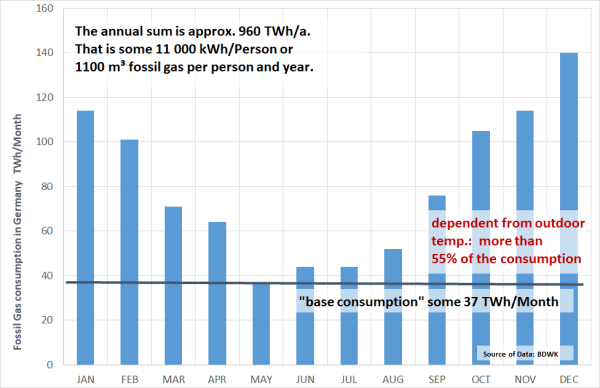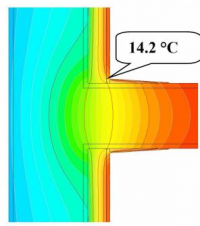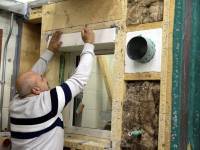Table of Contents
Natural gas and climate protection
Analysis by Wolfgang Feist (6.4.2022; amended 2.5.)
Germany seems particularly affected by the necessity of reducing the consumption of Russian gas. There is a lot of talk about how exactly this has come about and who was responsible for this. Here I will only point out ways to quickly and effectively get out of the “double bind” situation which some commentators seem to see here: reducing dependence on natural gas and reducing CO2 emissions at the same time, as has again been admonished urgently in the latest IPCC report. However, a preliminary note is necessary:
Natural gas is neither "climate-friendly" nor is it a " bridging technology"
…as believed by a great many people in the past decade in Germany. Natural gas is a fossil energy source - the production, distribution and combustion of which causes emission of CO2 as well as methane, an even more potent greenhouse gas 1). The greenhouse potential is even significantly higher when natural gas is liquefied for transportation and/or obtained by means of so-called “fracking”. In the coming 2 to 3 decades, natural gas will also have to be almost completely replaced by energy sources without a global warming potential 2). Increasing the consumption of pipeline-supplied natural gas to the extent apparently envisaged at one time for the coming years carries with it the risk that this will result in the reinforcement of a new dependence rather than providing a stopgap solution. Complete substitution of the (huge!) amounts of natural gas which are used, for example for space heating, by renewably generated gas will not happen anytime soon [EwR 2021] ; and if there is ever such a high level of production of synthethic gas (also often called P2G, “Pwer to Gas”, whether hydrogen or bio-methane or wind-gas), then gas that is generated in this way will always be (much more) expensive than the natural gas we are accustomed to today.
Rapid reduction?
Indeed, more than half the natural gas consumption today follows the outdoor temperature variation - and this means that this concerns heating applications with predominant heat losses towards the outside climate, especially space heating in all sectors 3).
| Monthly profile of natural gas consumption in Germany: the temperature-dependent proportion predominates. Data source: BDEW. The total amount is considerably higher than the electricity consumption in Germany, which is about 500 TWh/a. |  |
Why energy is at all necessary for this is due to the fact that we still continue to let this heat escape through inadequately protected roofs, façades, windows and ceilings 4). And that can be changed, even at short notice if necessary; not entirely within just one year 5), that is the consequence of dependencies that have built up over decades, but much faster in any case than many of the often-discussed major investments in nuclear fusion, new nuclear fission reactor types or hydrogen infrastructure. These are all highly concentrated investments with long design and construction phases and significantly higher energy costs than we are accustomed to at present. To avoid being misunderstood here: we will also need some new generation infrastructure 6), but this will be considerably stress-free if the losses are not as high as at present. The preferred full supply will even be possible with a sensitive expansion of wind-power, photovoltaics and substitution with renewably generated RE gas 7) for some industrial sectors. Other gas consumers, space heating in particular, can easily be supplied by the existing power grid by means of heat pumps and improved thermal protection. In this way, both goals can be effectively achieved: a quick way away from natural gas AND simultaneously the reduction of greenhouse gas emissions.
That's how it works...
For many decades, programmes for modernisation of the existing building stock were not prioritised; for this reason, significantly fewer buildings have been modernised in Germany each year (less than 2% per year) and usually to a completely inadequate standard. There is a modernisation backlog - there are many reasons for this, which we will not analyse here. However, this can be changed: if priority is now explicitly given to renovation in the building sector, then 5% of buildings 8) can be retrofitted annually. However, what is essential for this is that with every single one of these retrofits the potentials are actually utilised to the full extent. Quite contrary to frequently expressed opinions, it is hardly more expensive to “get it right” straightaway in the case of an already pending renovation; one just has to use triple glazing instead of double glazing, or correctly executed connection details instead of thermal bridges, and of course, avoid he use of a fuel-operated heating system again 9). How this works is described in the "euroPHit" project; an efficiency analysis has already been published on this subject: "Retrofit with Passive House components". How can this be implemented on a broad scale?
 By quickly making descriptions, instructions and methods available for all (this is exactly what we intend with the Now initiative, examples: interior insulation (German Page), loose-fill insulation (German Page)).
By quickly making descriptions, instructions and methods available for all (this is exactly what we intend with the Now initiative, examples: interior insulation (German Page), loose-fill insulation (German Page)).
- By making already trained energy consultants, Passive House experts and designers available for competent advice on "If you do it, do it right!"as soon as possible.
- By motivating the construction industry to set the focus on Energy efficient retrofit NOW! Every manufacturer of construction products can contribute to its success with their (optimised!) product. Often, it is not necessary to make any huge adjustments - but some know-how is needed, which is already available in the published (and freely accessible) work relating to EnerPHit .
 By creating additional capacities for the production of insulation materials from sustainable raw materials, e.g. for thermal insulation using straw (German page). There is more than enough “material” for this purpose - and experience has shown that it can contribute a very large part to thermal protection measures, especially in the case of one to two storey buildings. This would then constitute a double contribution towards sustainability.
By creating additional capacities for the production of insulation materials from sustainable raw materials, e.g. for thermal insulation using straw (German page). There is more than enough “material” for this purpose - and experience has shown that it can contribute a very large part to thermal protection measures, especially in the case of one to two storey buildings. This would then constitute a double contribution towards sustainability.
 By creating capacities for execution of work through fast further training of the trades disciplines. Jobs can be created here on a significant scale. Again, this would be a double contribution towards sustainability.
By creating capacities for execution of work through fast further training of the trades disciplines. Jobs can be created here on a significant scale. Again, this would be a double contribution towards sustainability.
- Immediate measures can often be carried out on a self-help basis. With good instructions and a “practical set-up”, the essential work processes can be learned in a few days - maybe not by everyone, but potential certainly exists here. This may contribute to success, especially in the first year, when things can get particularly difficult and everything has to be done fast.
 The switch to heat pumps can also be accelerated. This is certainly the most reasonable alternative to natural gas in terms of technical building systems - because renewably generated electricity can be used here directly and energy efficiently for heating via the existing power grid 10). Besides, this is easier, more cost-effective and environmentally compatible if the building is already upgraded in terms of energy efficiency; however, the reverse order may also work: a boiler that already needs to be renewed now can be replaced by a heat pump even in an existing building, possibly for bivalent operation at first. But as modernisation progresses, the heat pump can then assume the entire heating load - and that with an increasingly higher share of wind power from the power grid in the future, until this becomes a full renewable supply system in 15 to 20 years. We have examined in this paper what consequences occur for the electrical load in the network and the additional installation of wind turbines. Short summary: This change is definitely possible, it will take around two decades and has two prerequisites: a significant reduction in the heating requirement so that the entire winter load peak can be managed by the heat pumps and a rapid expansion of wind power.
The switch to heat pumps can also be accelerated. This is certainly the most reasonable alternative to natural gas in terms of technical building systems - because renewably generated electricity can be used here directly and energy efficiently for heating via the existing power grid 10). Besides, this is easier, more cost-effective and environmentally compatible if the building is already upgraded in terms of energy efficiency; however, the reverse order may also work: a boiler that already needs to be renewed now can be replaced by a heat pump even in an existing building, possibly for bivalent operation at first. But as modernisation progresses, the heat pump can then assume the entire heating load - and that with an increasingly higher share of wind power from the power grid in the future, until this becomes a full renewable supply system in 15 to 20 years. We have examined in this paper what consequences occur for the electrical load in the network and the additional installation of wind turbines. Short summary: This change is definitely possible, it will take around two decades and has two prerequisites: a significant reduction in the heating requirement so that the entire winter load peak can be managed by the heat pumps and a rapid expansion of wind power.
 There is a way in which the significant potential of additional mini heat pump units can even be made available: i.e. modern minisplit air conditioning units. These can be installed easily and economically- and can almost completely cover the heating in autumn and spring11) in the transitional period, helping to save gas. In case of emergency they can even heat a single room in the winter - with a higher output than a fan heater but only about one-third of the electricity consumption. We have described this in more detail here: heating with an air-conditioning unit (German page).
There is a way in which the significant potential of additional mini heat pump units can even be made available: i.e. modern minisplit air conditioning units. These can be installed easily and economically- and can almost completely cover the heating in autumn and spring11) in the transitional period, helping to save gas. In case of emergency they can even heat a single room in the winter - with a higher output than a fan heater but only about one-third of the electricity consumption. We have described this in more detail here: heating with an air-conditioning unit (German page).
- And of course, electricity generating photovoltaic systems (German page]) should be on as many roofs as possible! These already provide electricity more cheaply today than generated by fossil fuels. A whole range of other surfaces are also suitable for the expansion of PV. Even people living in rented homes can generate some electricity with 'balcony-systems' and save some $$ in this way 12)
We can address all these points in a focused way "NOW". These approaches will definitely mitigate the situation with the gas supply in the coming winter, but at the same time they will also reduce greenhouse gas emissions already in the first year, and will continue to do so in following years as well. These are measures which will help achieve the climate objectives and reduce dependency on gas, and each of these measures has even further, tangible benefits: professionally installed thermal protection increases the property value of the building and improves comfort - home ventilation with heat recovery serves primarily to provide good indoor air quality and split air conditioning units allow for a better indoor climate in summer in a world impacted by climate change. All of the measures described here have one thing in common: they increase competence of the trades, create meaningful jobs, and bring sustainable production to Europe. Whatever is needed for this can be obtained and produced in Europe.
And another, not at all unimportant point is: if difficulties on the supply side do actually arise, each of the mentioned measures will help to keep the home or at least some rooms warm, even in case of an emergency. In the worst case, things will still be bearable even in circumstances where there is no fuel at all, while the situation will be different in a poorly insulated building.
Sources
[EwR 2021] Engineering with Rosie: "Hydrogen in the Network": “Hydrogen in the Network” an eye-opener to the substitution of natural gas by green hydrogen. By the way: A process named after “Sabatier” allows the production of CH4 from hydrogen and C CO2 ; this would be technically possible, but with somewhat higher transformation losses, of course. So it's a good idea to use such RE gas efficiently - that is what PER-factor describes.
